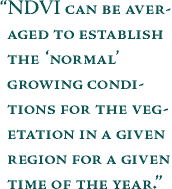

NDVI as an Indicator of Drought | |||
Satellite remote sensors can quantify what fraction of the photosynthetically active radiation is absorbed by vegetation. In the late 1970s, scientists found that net photosynthesis is directly related to the amount of photosynthetically active radiation that plants absorb. In short, the more a plant is absorbing visible sunlight (during the growing season), the more it is photosynthesizing and the more it is being productive. Conversely, the less sunlight the plant absorbs, the less it is photosynthesizing, and the less it is being productive. Either scenario results in an NDVI value that, over time, can be averaged to establish the "normal" growing conditions for the vegetation in a given region for a given time of the year. In short, a region’s absorption and reflection of photosynthetically active radiation over a given period of time can be used to characterize the health of the vegetation there, relative to the norm.
The difference between the average NDVI for a particular month of a given year (such as August 1993, above) and the average NDVI for the same month over the last 20 years is called NDVI anomaly. (Compare the August 1993 NDVI anomaly to August 1993 NDVI and Average August NDVI in North America.) In most climates, vegetation growth is limited by water so the relative density of vegetation is a good indicator of agricultural drought. The above image shows the NDVI anomaly in the U.S. for August 1993. In that year, heavy rain in the Northern Great Plains (North and South Dakota, Alberta, and Saskatchewan) led to flooding in the Missouri River. The resulting exceptionally lush vegetation appears as a positive anomaly (green). Concurrently, in the Eastern U.S., rainfall was very low, and the region exhibited a strong negative anomaly (dark red). Today, researchers at NASA and NOAA have two decades of NDVI data over the entire globe. Comparing this month’s or this year’s NDVI data with the 20-year average reveals whether the productivity in a given region is typical, or whether the plant growth is significantly more or less productive. So for the purposes of this Web site, a given region in which there is a period of reduced plant growth (due to a lack of precipitation) is labeled as "in drought." Other possible causes for lower than normal NDVI are exceptionally cold temperatures (which can delay or cut short the growing season) and clouds. next: Enhanced Vegetation Index (EVI)
|
 Measuring Vegetation (NDVI & EVI)
| ||